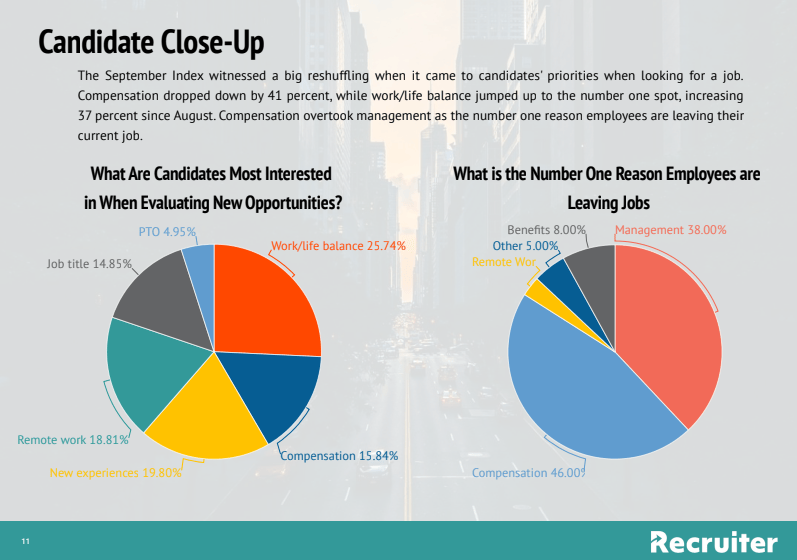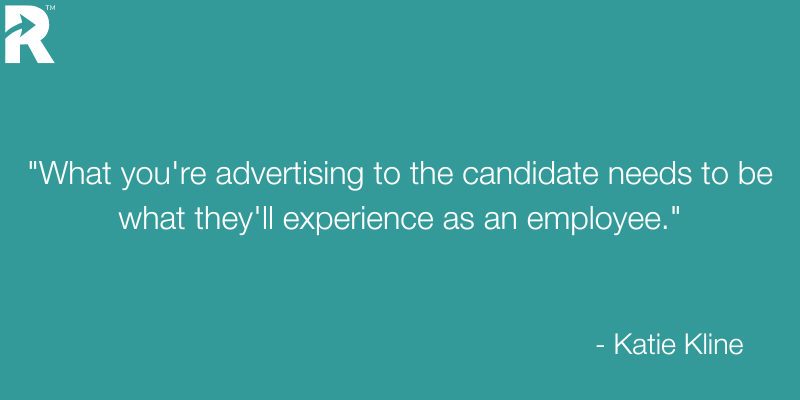Webinar: Overcoming Recruiting and Sourcing Challenges

With a possible recession on the horizon of the economy, many companies are pausing, leading some to dub this the “Great Hesitation.”
This can be the perfect opportunity for some companies to start building up their pipeline and finding and sourcing talent that can help your company weather this storm. Katie Kline, the Customer Success Associate at Recruiter.com, and Neeta Maliakal, the Global Head of Talent Acquisition at Velocity Global, partnered up in October to host a webinar that can help companies overcome common sourcing struggles to recruit talent successfully.
You can watch the webinar here, but if you don’t have time, keep reading to hear about critical highlights that can help your recruiting efforts.
What Are the Most Common Sourcing Challenges?
According to Maliakal, one of the biggest challenges in sourcing is grabbing a candidate’s attention. There is an art and science to it, though.
Maliakal breaks down both sides of it. The art stands for the optics that your company presents. It defines who your business is and what it stands for. All these are essential factors in converting a lead to a candidate interested in the job.
Employer branding and recruitment marketing are two crucial aspects of this. However, companies forget that the employee experience will need to match the marketing that you’re doing. For example, if you say that you offer remote work, but employees only work remotely one day a week, then candidates (and employees) will start to notice this gap, which could hurt your recruiting efforts.
Many websites will help give candidates insights into what it’s like to work for your company. If those are primarily negative, you’re going to have a hard time converting candidates.
“Sourcing is all about consumer protection,” said Maliakal. The sourcing marketing needs to be backed up with real employee experience.
On the flip side, businesses will need to think about the science of the job. What would draw candidates in and give them a reason to apply for the job or be interested in considering it?
While compensation might seem the biggest priority for candidates, the September 2022 Recruiter Index shows that candidates consider other things when looking for a job.
For example, work-life balance was the most important factor for candidates when they were considering a new opportunity. Remote work was the second most important factor, with new experiences coming in third. Compensation ranked fourth, above the job title and the PTO. Understanding these priorities will help you figure out what to offer to candidates in order for them to accept the position.

Maliakal said that companies should consider different advertising benefits, like:
- A three or five-year strategy of a candidate’s journey with that company
- Flexible working styles and schedules
- Employee resource groups
- DEI initiatives
- Healthcare benefits
- Aligned company values
- Flexible vacation time
This could help your company find great talent while also not breaking your budget.
What Should Smaller Companies Do When They Can’t Find Niche Talent?

After the Great Resignation, smaller companies and startups know how difficult it can be to find, especially niche talent.
Smaller hiring companies face challenges because they are newer and have less employer brand recognition than larger companies, like Google or Facebook. Because they’re a smaller, newer company, they may also not be able to compete with the high salaries that employees are looking for.
However, some of the challenges are that their talent pool is too small, and they don’t know how to source that niche talent. Maliakal recommends first assessing why it’s hard for that company to find talent.
They can start by assessing the talent pool in the market and figuring out how many candidates are in that market. You can also use different tools and resources that recruiters have available, like AI-powered recruiting software. While AI recruiting software is powerful, recruiters can’t use it in every situation. However, one thing that it’s good at is talent mapping because it can give you real-time data on the industry.
You’ll need to analyze the company’s recruiting structure if you confirm that there is a large talent pool and that’s not the issue with your sourcing. Are they designed for speed or stability? In general, you want the company to be built for both.
Even a small startup can have leadership that is dedicated to helping with hiring and creating a strategy for the future.
“Let’s redesign or build teams to move from acting agile out of necessity to being agile by design,” said Maliakal.
These recruiters can help by convincing company leadership to design an agile hiring process, so companies aren’t scrambling to react to the market. Since the market is very volatile and will continue to be so with a possible recession, it can help companies have a long-term plan to help them recruit top talent.
Tips for Minimizing Drop Off

Small and large companies deal with candidate drop-offs. You spend all this time sourcing a candidate, and then they either ghost you or decide they don’t want to continue the recruiting process.
One thing that you can do to help manage this is to ensure that these candidates connect with a human as soon as possible. AI is a powerful tool and can help the recruiting process, but Maliakal advises that it should help humans, not replace a human element.
For example, you can use it to help manage assessment prompts or find the right time to schedule an interview. You can send automated emails, but you want to ensure that a candidate can reach out to a human recruiter if they need something.
Kline also mentioned that companies need to be aware of their employer brand. Everything is available on the Internet now, and sites like Glassdoor make it easy for candidates to learn more about what it’s like to work at a specific company. This is an essential part of the job hunting process for candidates now.
“What you’re advertising to the candidate needs to be what they’ll experience as an employee,” Kline said. If candidates find that the benefits or culture you present in your job description don’t match what actual employees say, you’ll experience a lot of drop-offs.
To minimize that, take the time to review your job descriptions and tailor them for each position. You may want to check your employee reviews and figure out where you can improve as a company. You can send employees an anonymous survey to figure out where you can improve internally so that you have a better chance of attracting top talent.
What Should Companies Do When They Have a Hard Time Sourcing in This Market?
With a volatile job market, companies can have difficulty finding candidates. However, Maliakal said that if companies are struggling with this, they can leverage the recruiters they are working with.
“The best research comes from recruiters. Recruiters are on the front lines talking to customers and candidates,” said Maliakal. They can help provide feedback on what’s working and what’s not.
You can also try expanding your talent pool. You might need to review your compensation offerings. If you’re hiring in only one area, you may automatically extend your search area to grow your talent pool.
As mentioned above, sometimes you don’t need to add $20,000 to a salary. It could be something as simple as expanding benefits or opening the door to remote candidates.
What Happens When You Exhaust the Talent Pool?
When you’ve gone through your talent pool and still haven’t found the right candidate, Maliakal suggests reviewing the job description. Hiring managers often won’t review the job description before sharing it, and the job descriptions might ask for too high and unrealistic qualifications.
As Kline mentioned, some recruiters are looking for a purple squirrel or unicorn candidate, which will make your candidate pool much smaller. Go back to the job description and figure out what you need to accomplish with the job description.
This may mean you must work with a hiring manager to understand the job scope.
“Stand your ground to understand the job scope,” Maliakal said. “It’s perhaps best to look at that job description to see who we’re looking for.”
If the job description is already accurate and narrowed down, you may need to partner with other companies for help. For example, Recruiter.com can provide you with contract recruiters to help you find the perfect candidate.
Along with their vast recruiting knowledge and experience, they will also bring along their contacts and networks. They may have connections to your ideal candidate, which can also quicken the recruiting process.
Contact us today if you’re interested in learning more about our on-demand recruiting solutions !
Get the top recruiting news and insights delivered to your inbox every week. Sign up for the Recruiter Today newsletter.

